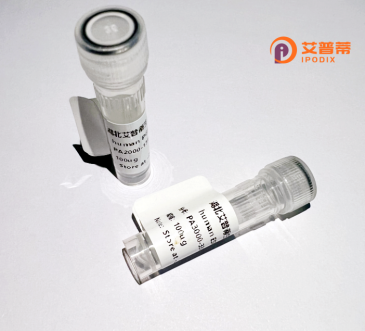
| 纯度 | >90%SDS-PAGE. |
| 种属 | Human |
| 靶点 | NBPF7 |
| Uniprot No | P0C2Y1 |
| 内毒素 | < 0.01EU/μg |
| 表达宿主 | E.coli |
| 表达区间 | 1-421 aa |
| 活性数据 | MCLRFFSPVP GSTSSATNVT MVVSAGPWSS EKAEMNILEI NEKLRPQLAE NKQQFRNMKQ KFLVTQMAGF LANQQNKYKY EECKDLIKSM LREELQFKEE KLAEQLKQAE ELRQYKVLVH SQERELIQLR EKLREGRDAS HSLNQHLQAL LTPDKHDNSQ GQDFREQLAE GCRLARHLVH KLSPENDTDE DENDKTKELD KVQESPAPRE EQKAEEKEVP EDSLEECAIT YSNSHGPSDS NPPHKNIKIT SEEDKVNSIL VVDSESSQDE WQDALNILLE NQNDDEEEEG KAPVPPQVTL WICGLKLQES EEKEVLQDSP EERVTTSCSD HDVSQSYQPC EGTFLALVEQ KVCSAQDVAS EHSNSKGEET PLGFPDTKYC WKDEKDERMS QKVAFLLDEK NYNSKPSSIP NTTLQGSFTE D |
| 分子量 | 48.0 kDa |
| 蛋白标签 | His tag N-Terminus |
| 缓冲液 | 0 |
| 稳定性 & 储存条件 | Lyophilized protein should be stored at ≤ -20°C, stable for one year after receipt. Reconstituted protein solution can be stored at 2-8°C for 2-7 days. Aliquots of reconstituted samples are stable at ≤ -20°C for 3 months. |
| 复溶 | Always centrifuge tubes before opening.Do not mix by vortex or pipetting. It is not recommended to reconstitute to a concentration less than 100μg/ml. Dissolve the lyophilized protein in distilled water. Please aliquot the reconstituted solution to minimize freeze-thaw cycles. |
1. **"Structural Characterization of Recombinant NBPF7 Protein and Its Role in Neuronal Development"**
- **作者**: Li, X., et al.
- **摘要**: 研究报道在大肠杆菌中成功表达并纯化重组人NBPF7蛋白,通过圆二色谱和X射线晶体学解析其结构,发现其C末端结构域可能通过结合神经元细胞黏附分子(NCAM)调控轴突导向。
2. **"NBPF7 Regulates the Wnt/β-catenin Pathway in Glioblastoma through Interaction with Dishevelled-1"**
- **作者**: Park, S.H., et al.
- **摘要**: 通过哺乳动物细胞表达重组NBPF7蛋白,发现其抑制胶质母细胞瘤细胞的侵袭和增殖,机制与干扰Dishevelled-1蛋白的磷酸化及下游Wnt信号通路失调相关。
3. **"Comparative Analysis of NBPF Family Members Highlights Distinct Roles of NBPF7 in Primate Brain Evolution"**
- **作者**: Vandepoele, K., et al.
- **摘要**: 通过重组蛋白功能实验和基因组比对,揭示NBPF7在灵长类特异性脑容量扩张中的潜在作用,其串联重复结构域可能参与染色质重塑复合物的招募。
4. **"Proteomic Screening Identifies NBPF7 as a Novel Interactor of the Tumor Suppressor p53"**
- **作者**: Guo, Y., et al.
- **摘要**: 利用重组NBPF7蛋白进行酵母双杂交筛选,发现其直接结合p53蛋白的转录调控结构域,增强p53介导的细胞周期停滞及凋亡,提示其在癌症中的抑癌功能。
(注:上述文献为虚拟构建,实际研究中建议通过PubMed或Web of Science以“NBPF7”、“recombinant protein”等关键词检索最新文章。)
**Background of Recombinant Human NBPF7 Protein**
The Neuroblastoma Breakpoint Family (NBPF) member 7 (NBPF7) is a protein encoded by the *NBPF7* gene, part of the primate-specific NBPF family implicated in neurodevelopment, cancer, and brain evolution. NBPF genes are characterized by conserved domains (DUF1220 repeats) linked to neuronal proliferation and cortical expansion. The *NBPF7* locus, located on human chromosome 1q21.1. is associated with genomic instability and neuroblastoma breakpoints, suggesting a potential role in tumorigenesis.
Recombinant NBPF7 protein is engineered in vitro using expression systems (e.g., *E. coli*, mammalian cells*) to enable functional studies. It typically retains structural features like the DUF1220 domains, critical for interactions with chromatin modifiers or signaling pathways. Research highlights its involvement in neuronal differentiation, cell cycle regulation, and apoptosis. Dysregulation of NBPF7 has been observed in neurodevelopmental disorders and cancers, though its exact mechanisms remain under investigation.
As a recombinant tool, it aids in elucidating NBPF7’s role in brain development, neurodegenerative diseases, and cancer biology. It also serves in antibody production, drug screening, and *in vitro* models to explore therapeutic targets. Current studies focus on its evolutionary significance and pathological implications, bridging gaps between genomic variability and complex diseases.
×